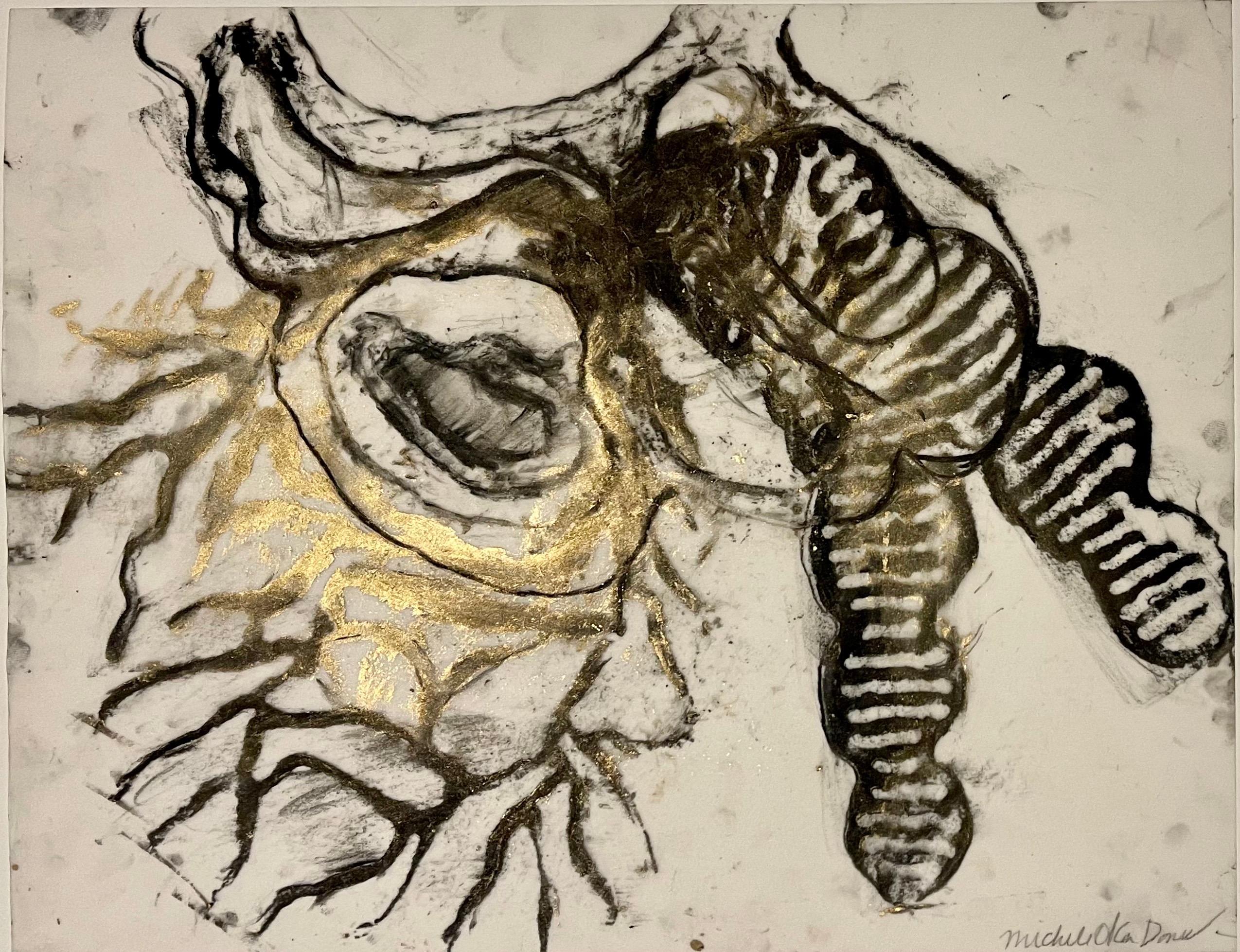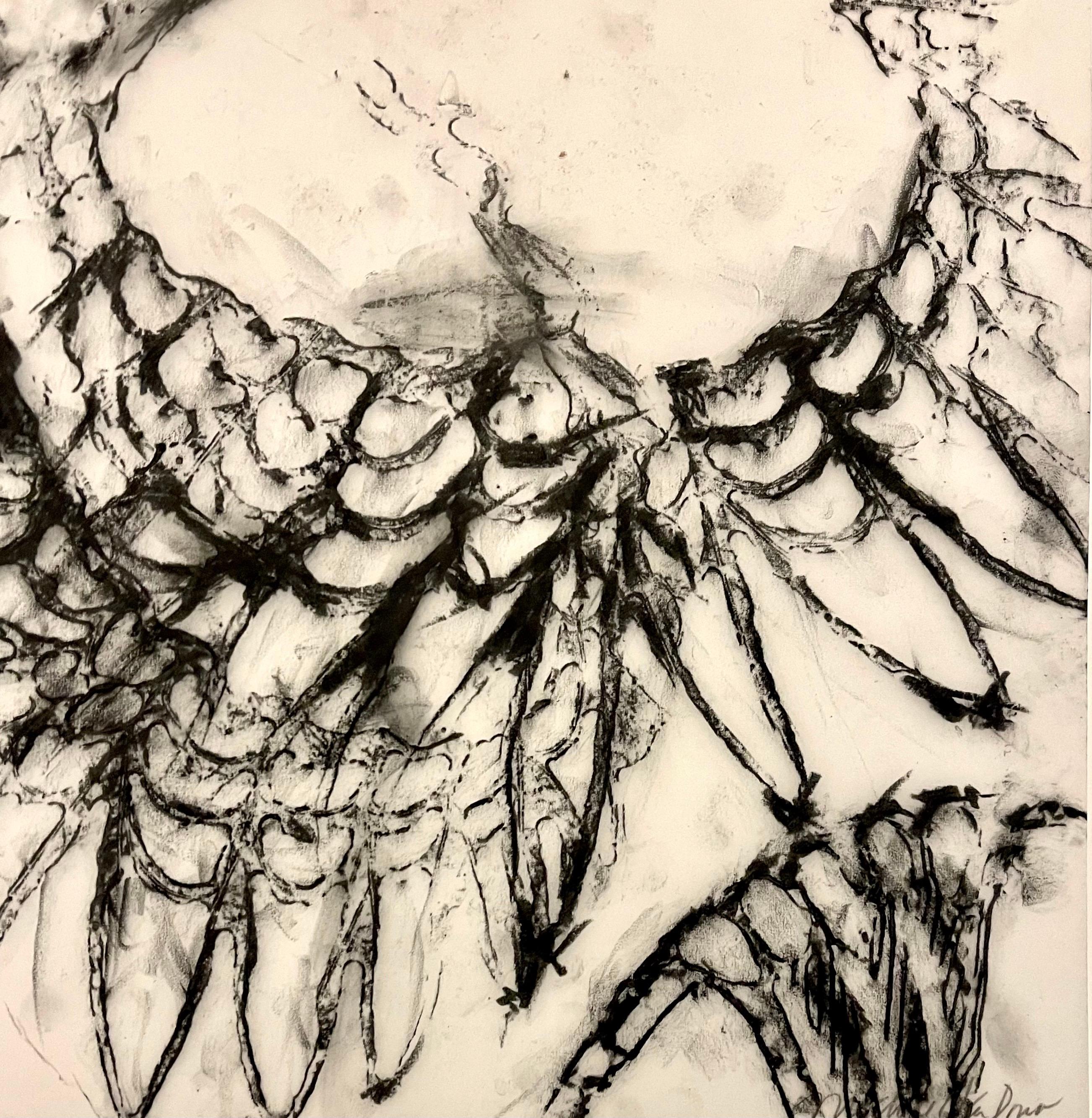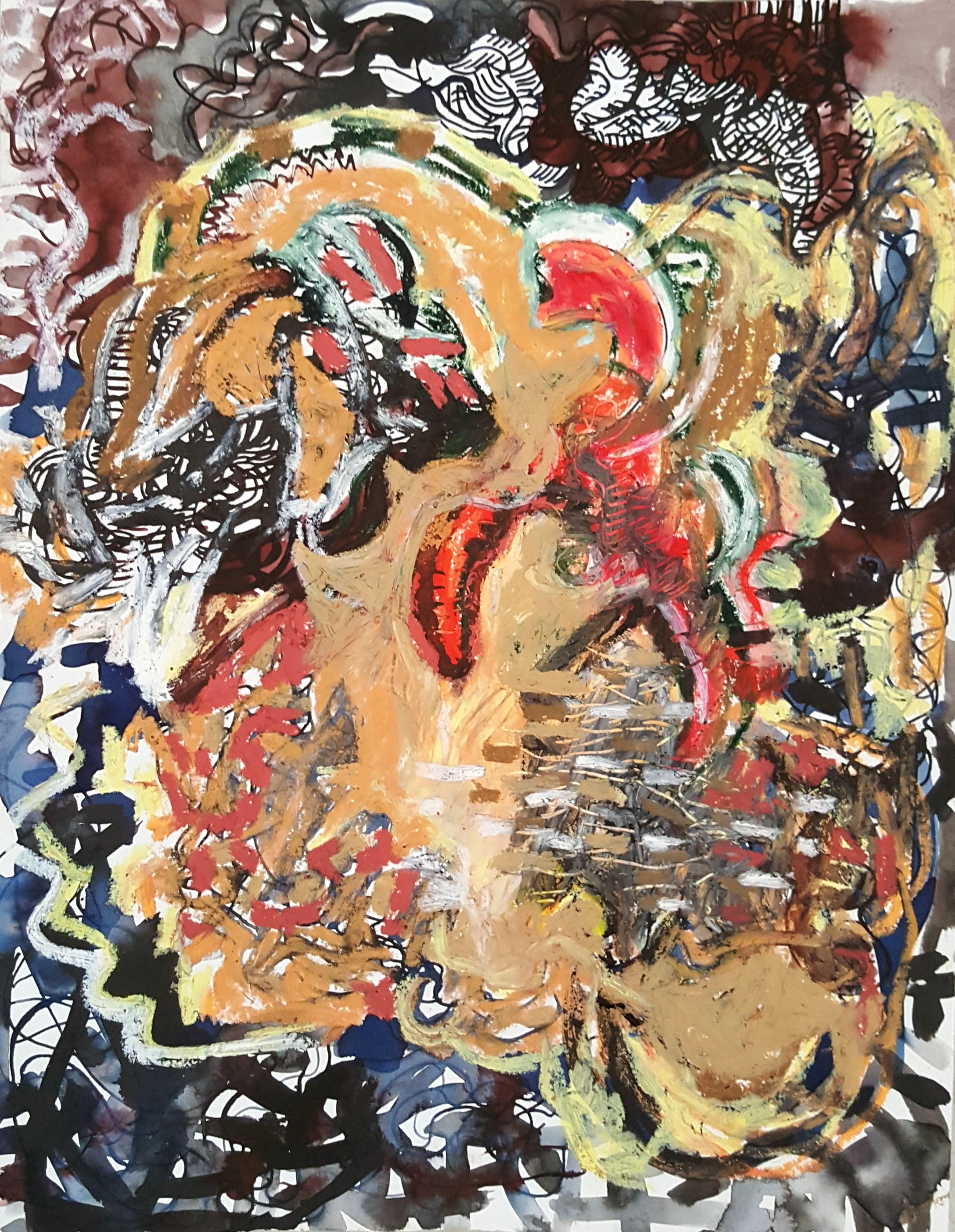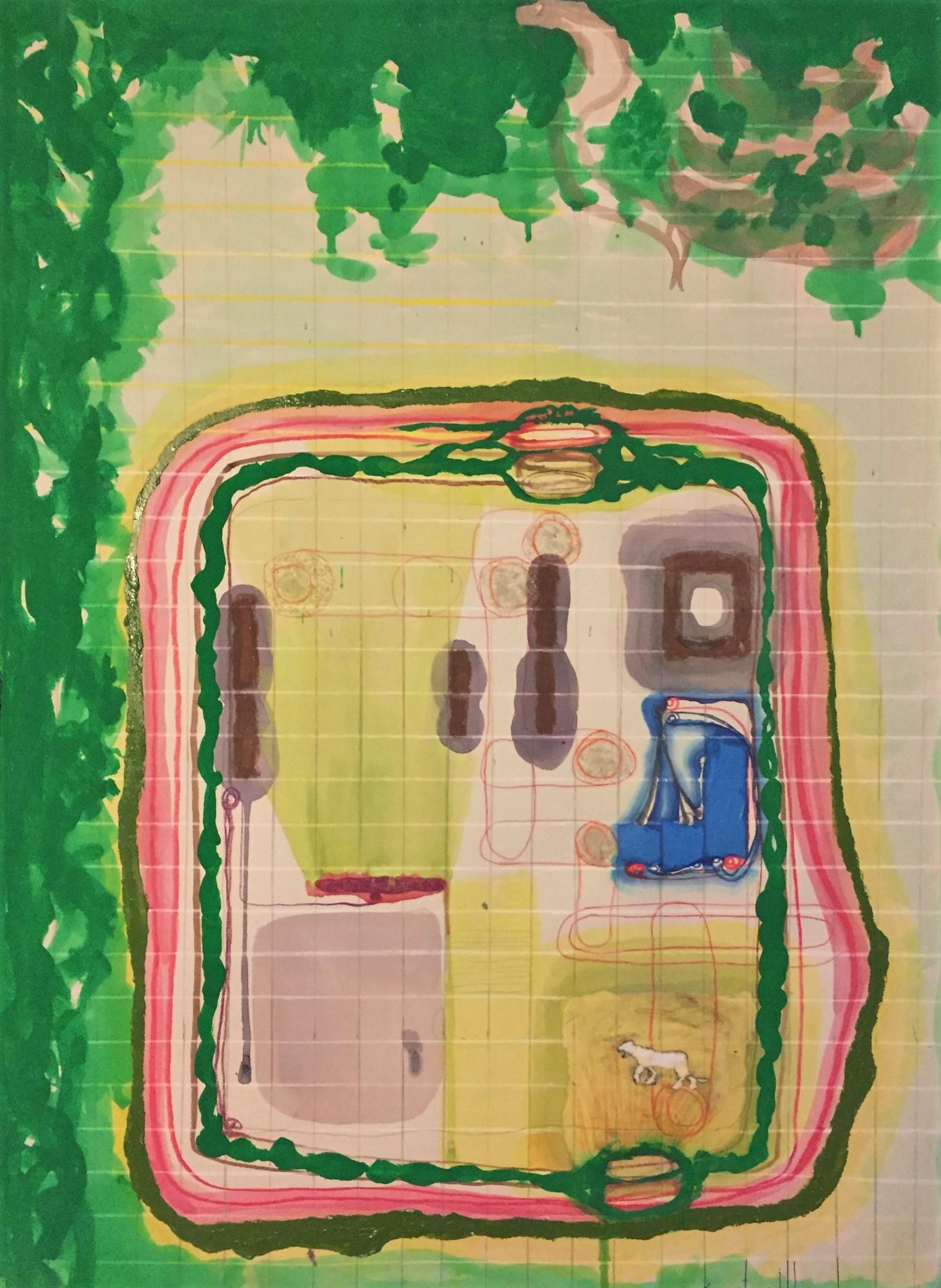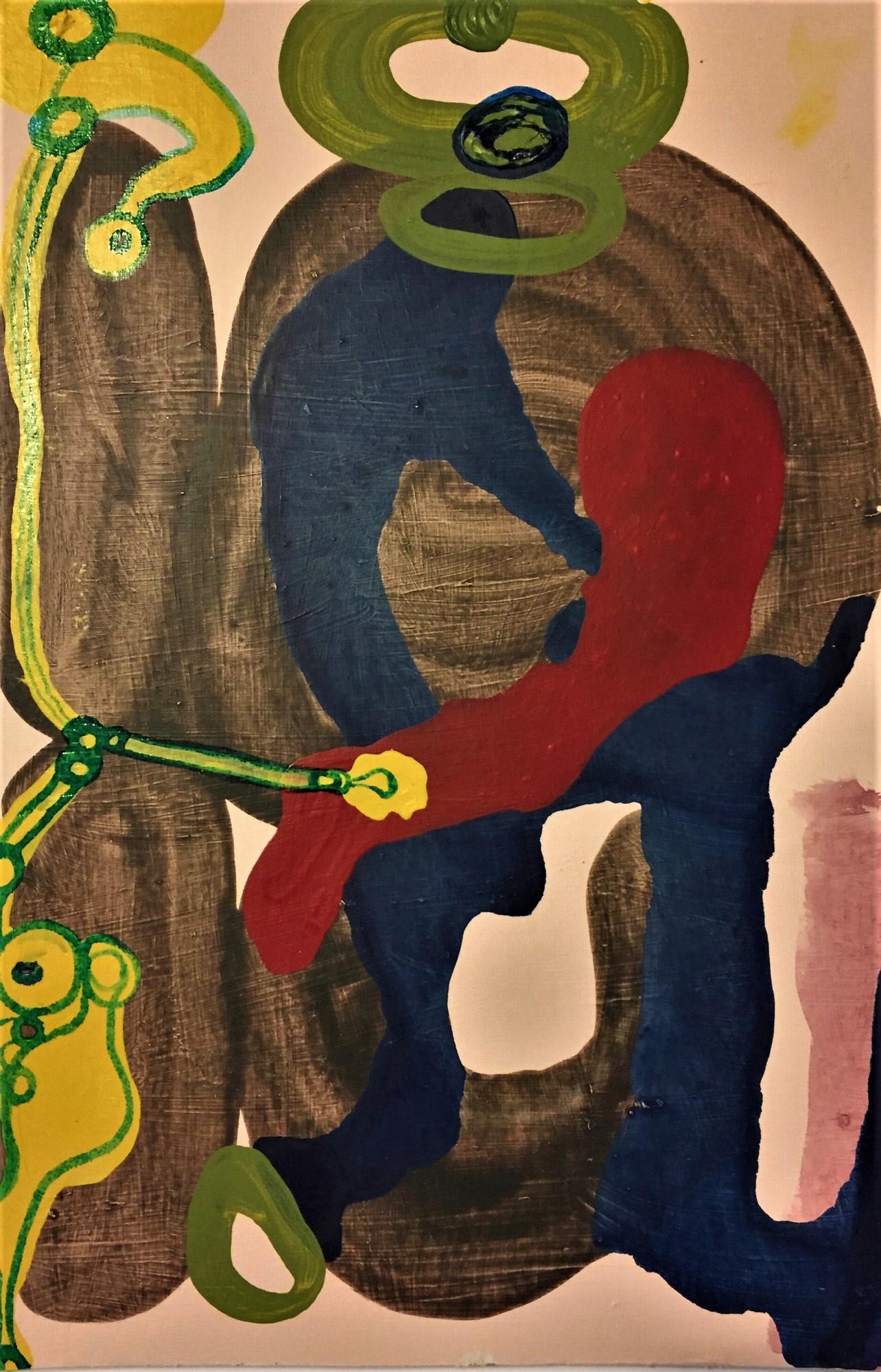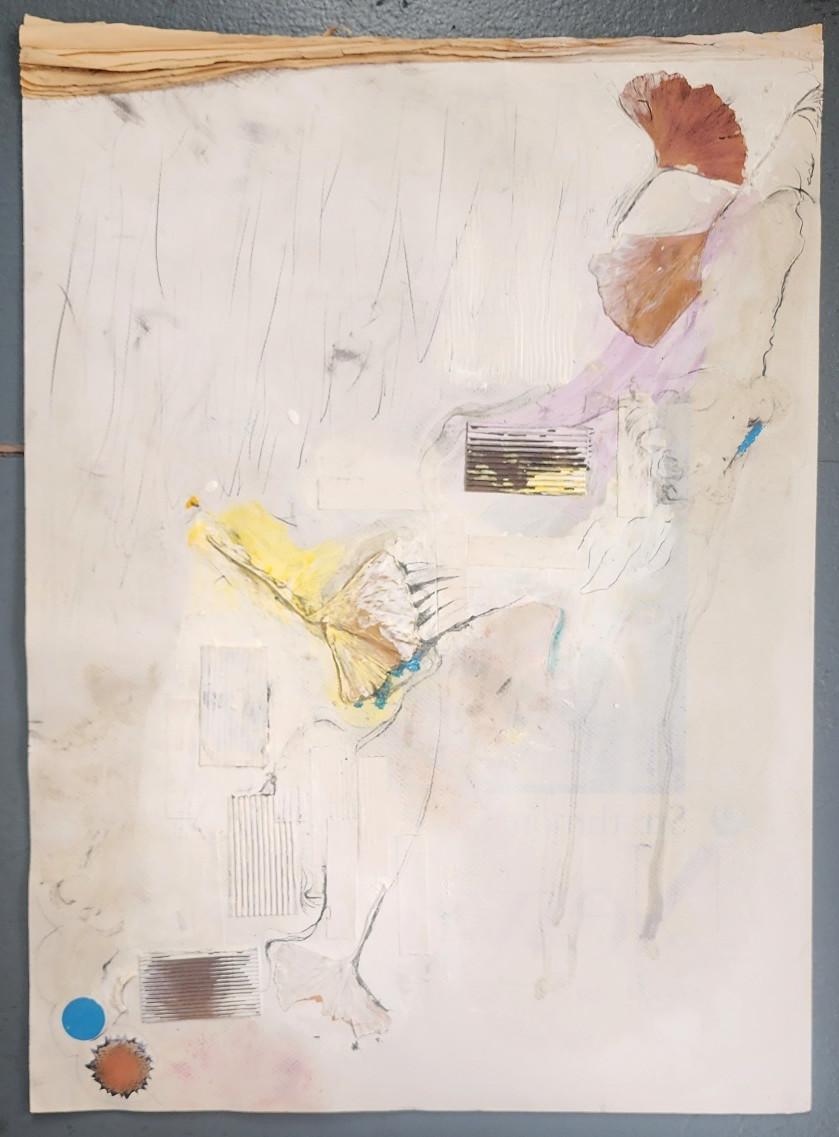
"Collected Dream Images" 1974 Monochromatic Abstract Ink & Collage in Gold Frame
1 of 7
Elsa Warner"Collected Dream Images" 1974 Monochromatic Abstract Ink & Collage in Gold FrameCirca 1974
Circa 1974
About the Item
- Creator:Elsa Warner (1900 - 1988, American)
- Creation Year:Circa 1974
- Dimensions:Height: 19 in (48.26 cm)Width: 16 in (40.64 cm)Depth: 0.5 in (1.27 cm)
- Medium:
- Movement & Style:
- Period:
- Condition:Paint loss on frame front and corners.
- Gallery Location:San Francisco, CA
- Reference Number:Seller: 884411stDibs: LU29824180661
You May Also Like
- 1950s Abstract Composition in Brown, Orange and Blue with Black Parallel LinesBy Herbert BayerLocated in Denver, COWatercolor and ink on paper of an abstract composition of brown, orange and blue shapes between black parallel lines throughout the the piece by Herbert Bayer (1900-1985). Presented in a custom black frame with all archival materials. Framed dimensions measure 17 ⅞ x 22 ⅝ x 1 inches. Image size is 10 ¼ x 15 ½ inches. Painting is clean and in very good condition - please contact us for a detailed condition report. Expedited and international shipping is available - please contact us for a quote. About the Artist: Herbert Bayer enjoyed a versatile sixty-year career spanning Europe and America that included abstract and surrealist painting, sculpture, environmental art, industrial design, architecture, murals, graphic design, lithography, photography and tapestry. He was one of the few “total artists” of the twentieth century, producing works that “expressed the needs of an industrial age as well as mirroring the advanced tendencies of the avant-garde.” One of four children of a tax revenue officer growing up in a village in the Austrian Salzkammergut Lake region, Bayer developed a love of nature and a life-long attachment to the mountains. A devotee of the Vienna Secession and the Vienna Workshops (Wiener Werkstätte) whose style influenced Bauhaus craftsmen in the 1920s, his dream of studying at the Academy of Art in Vienna was dashed at age seventeen by his father’s premature death. In 1919 Bayer began an apprenticeship with architect and designer, Georg Schmidthamer, where he produced his first typographic works. Later that same year he moved to Darmstadt, Germany, to work at the Mathildenhöhe Artists’ Colony with architect Emanuel Josef Margold of the Viennese School. As his working apprentice, Bayer first learned about the design of packages – something entirely new at the time – as well as the design of interiors and graphics of a decorative expressionist style, all of which later figured in his professional career. While at Darmstadt, he came across Wassily Kandinsky’s book, Concerning the Spiritual in Art, and learned of the new art school, the Weimar Bauhaus, in which he enrolled in 1921. He initially attended Johannes Itten’s preliminary course, followed by Wassily Kandinsky’s workshop on mural painting. Bayer later recalled, “The early years at the Bauhaus in Weimar became the formative experience of my subsequent work.” Following graduation in 1925, he was appointed head of the newly-created workshop for print and advertising at the Dessau Bauhaus that also produced the school’s own print works. During this time he designed the “Universal” typeface emphasizing legibility by removing the ornaments from letterforms (serifs). Three years later he left the Bauhaus to focus more on his own artwork, moving to Berlin where he worked as a graphic designer in advertising and as an artistic director of the Dorland Studio advertising agency. (Forty years later he designed a vast traveling exhibition, catalog and poster -- 50 Jahre Bauhaus -- shown in Germany, South America, Japan, Canada and the United States.) In pre-World War II Berlin he also pursued the design of exhibitions, painting, photography and photomontage, and was art director of Vogue magazine in Paris. On account of his previous association with the Bauhaus, the German Nazis removed his paintings from German museums and included him among the artists in a large exhibition entitled Degenerate Art (Entartete Kunst) that toured German and Austrian museums in 1937. His inclusion in that exhibition and the worsening political conditions in Nazi Germany prompted him to travel to New York that year with Marcel Breuer, meeting with former Bauhaus colleagues, Walter Gropius and László Moholy-Nagy to explore the possibilities of employment after immigration to the United States. In 1938 Bayer permanently relocated to the United States, settling in New York where he had a long and distinguished career in practically every aspect of the graphic arts, working for drug companies, magazines, department stores, and industrial corporations. In 1938 he arranged the exhibition, “Bauhaus 1919-1928” at the Museum of Modern Art, followed later by “Road to Victory” (1942, directed by Edward Steichen), “Airways to Peace” (1943) and “Art in Progress” (1944). Bayer’s designs for “Modern Art in Advertising” (1945), an exhibition of the Container Corporation of America (CAA) at the Art Institute of Chicago, earned him the support and friendship of Walter Paepcke, the corporation’s president and chairman of the board. Paepcke, whose embrace of modern currents and design changed the look of American advertising and industry, hired him to move to Aspen, Colorado, in 1946 as a design consultant transforming the moribund mountain town into a ski resort and a cultural center. Over the next twenty-eight years he became an influential catalyst in the community as a painter, graphic designer, architect and landscape designer, also serving as a design consultant for the Aspen Cultural Center. In the summer of 1949 Bayer promoted through poster design and other design work Paepcke’s Goethe Bicentennial Convocation attended by 2,000 visitors to Aspen and highlighted by the participation of Albert Schweitzer, Arthur Rubenstein, Jose Ortega y Gasset and Thornton Wilder. The celebration, held in a tent designed by Finnish architect Eero Saarinen, led to the establishment that same year of the world-famous Aspen Music Festival and School regarded as one of the top classical music venues in the United States, and the Aspen Institute for Humanistic Studies in (now the Aspen Institute), promoting in Paepcke’s words “the cross fertilization of men’s minds.” In 1946 Bayer completed his first architecture design project in Aspen, the Sundeck Ski Restaurant, at an elevation of 11,300 feet on Ajax Mountain. Three years later he built his first studio on Red Mountain, followed by a home which he sold in 1953 to Robert O. Anderson, founder of the Atlantic Richfield Company who became very active in the Aspen Institute. Bayer later designed Anderson’s terrace home in Aspen (1962) and a private chapel for the Anderson family in Valley Hondo, New Mexico (1963). Transplanting German Bauhaus design to the Colorado Rockies, Bayer created along with associate architect, Fredric Benedict, a series of buildings for the modern Aspen Institute complex: Koch Seminar Building (1952), Aspen Meadows guest chalets and Center Building (both 1954), Health Center and Aspen Meadows Restaurant (Copper Kettle, both 1955). For the grounds of the Aspen Institute in 1955 Bayer executed the Marble Garden and conceived the Grass Mound, the first recorded “earthwork” environment In 1973-74 he completed Anderson Park for the Institute, a continuation of his fascination with environmental earth art. In 1961 he designed the Walter Paepcke Auditorium and Memorial Building, completing three years later his most ambitious and original design project – the Musical Festival Tent for the Music Associates of Aspen. (In 2000 the tent was replaced with a design by Harry Teague.) One of Bayer’s ambitious plans from the 1950s, unrealized due to Paepcke’s death in 1960, was an architectural village on the outskirts of the Aspen Institute, featuring seventeen of the world’s most notable architects – Walter Gropius, Marcel Breuer, I.M. Pei, Minoru Yamasaki, Edward Durrell Stone and Phillip Johnson – who accepted his offer to design and build houses. Concurrent with Bayer’s design and consultant work while based in Aspen for almost thirty years, he continued painting, printmaking, and mural work. Shortly after relocating to Colorado, he further developed his “Mountains and Convolutions” series begun in Vermont in 1944, exploring nature’s fury and repose. Seeing mountains as “simplified forms reduced to sculptural surface in motion,” he executed in 1948 a series of seven two-color lithographs (edition of 90) for the Colorado Springs Fine Arts Center. Colorado’s multi-planal typography similarly inspired Verdure, a large mural commissioned by Walter Gropius for the Harkness Commons Building at Harvard University (1950), and a large exterior sgraffito mural for the Koch Seminar Building at the Aspen Institute (1953). Having exhausted by that time the subject matter of “Mountains and Convulsions,” Bayer returned to geometric abstractions which he pursued over the next three decades. In 1954 he started the “Linear Structure” series containing a richly-colored balance format with bands of sticks of continuously modulated colors. That same year he did a small group of paintings, “Forces of Time,” expressionist abstractions exploring the temporal dimension of nature’s seasonal molting. He also debuted a “Moon and Structure” series in which constructed, architectural form served as the underpinning for the elaboration of color variations and transformations. Geometric abstraction likewise appeared his free-standing metal sculpture, Kaleidoscreen (1957), a large experimental project for ALCOA (Aluminum Corporation of America) installed as an outdoor space divider on the Aspen Meadows in the Aspen Institute complex. Composed of seven prefabricated, multi-colored and textured panels, they could be turned ninety degrees to intersect and form a continuous plane in which the panels recomposed like pieces of a jigsaw puzzle. He similarly used prefabricated elements for Articulated Wall, a very tall free-standing sculpture commissioned for the Olympic Games in Mexico...Category
1950s Abstract Geometric Abstract Drawings and Watercolors
MaterialsPaper, Ink, Mixed Media, Watercolor
- "Abstract Butterfly, " Mixed Media Ink and Watercolor signed by Joan DvorskyBy Joan DvorskyLocated in Milwaukee, WIIn this artwork, Milwaukee-based artist Joan Dvorsky presents the viewer with a composition of shapes and colors that abstractly and subtly resemble a beautiful, colorful and complex...Category
2010s Abstract Mixed Media
MaterialsInk, Mixed Media, Watercolor
- Color Circle and StarBy Polly ApfelbaumLocated in New York, NYPolly Apfelbaum Color Circle and Star, 2004 Fabric Marker and Fabric Dye on Velvet Cotton Signed and dated in ink by the artist on the front with artist's inkstamp. Frame Included Si...Category
Early 2000s Abstract Geometric Mixed Media
MaterialsFabric, Dye, Ink, Mixed Media, Permanent Marker
- Original Drawing Painting Abstract Biomorphic Art Gold Leaf Michele Oka DonerBy Michele Oka DonerLocated in Surfside, FLThis is mixed media. I am not positive of the materials. it is a translucent, vellum, parchment type of paper. with either charcoal or ink and gold leaf (or gold paint) hand signed in pencil lower right. It is not titled on it. Michele Oka Doner (born 1945, Miami Beach, Florida, United States) is an American artist and author who works in a variety of media including sculpture, lithograph and woodcut prints, drawing, watercolor painting, functional objects and video. Her workes is based on flora, fauna, DNA and all sorts of exotica. She has also worked in costume and set design and has created over 40 public and private permanent art installations, including her best known artwork is "A Walk on the Beach" (1995, 1999), and its extension, "A Walk on the Beach: Tropical Gardens" (1996–2010) at the Miami International Airport. It is composed of over 9000 bronzes embedded in terrazzo with mother-of-pearl. At one and quarter linear miles, it is one of the largest artworks in the world. Born and raised in Miami Beach, Oka Doner is the granddaughter of painter Samuel Heller. Oka Doner's father, Kenneth Oka, was elected judge and mayor of Miami Beach during her youth (1945–1964). The family lived a public and politically active life. In later years, Oka Doner co-authored, with Mitchell Wolfson Jr. Miami Beach: Blueprint of an Eden, an intimate portrayal of Miami Beach from the 1920s to the 1960s using their families as prisms to reflect the times. Reviewed as classic of social history, with material that was part of the public record of its time, it was used as a textbook in Human Geography at George Washington University in 2008. In 1957, age 12, Oka Doner began a year-long independent project studying the International Geophysical Year (IGY). She assembled a book of drawings, writings and collages that became a template for projects realized in later years. In 1963, Oka Doner left Florida for the University of Michigan, Ann Arbor. Her art instructor Milton Cohen was experimenting with The Space Theater and George Manupelli began the Ann Arbor Film Festival. Their students were engaged in poetry, dance, light, music, all combined into a unitary vision, a motif that shaped Oka Doner's student years and is characteristic of her work today. Oka Doner participated in a Manupelli experimental film, a "Map Read" performance with art drawing instructor Al Loving and Judsonite dancer Steve Paxton as well as several "Happenings." Another influence was art historian and Islamic scholar, Oleg Grabar, who illustrated how patterns in architecture are able to dissolve space. A Death Mask, one of her first works, was selected as the cover of Generation, the University's avant garde journal, as campus unrest over the Vietnam war escalated. Her Tattooed Porcelain Dolls were adopted by students protesting the U.S.'s use of napalm... their heads (when they have them) with eyes closed, moth half-open and brain visible, fall into the category of surrealistic objects, but with a surrealism filled with a sap which is naive, barbaric and young." Oka Doner received a Bachelor of Science and Design from the University of Michigan (1966), a M.F.A. (1968), was Alumna-in-Residence (1990), received the Distinguished Alumna Award from the School of Art (1994) and was a Penny Stamps Distinguished Speaker (2008). She was awarded the honorary degree, Doctor of Arts (2016). Upon graduation in 1968, Oka Doner established a studio in downtown Ann Arbor behind the art gallery "Editions, Inc.," where physicist Lloyd Cross and sculptor Jerry Pethick were experimenting with holography. Using a krypton laser, they created the first art holograms. One of Oka Doner's sculptures was appropriated for this experiment. The "Ceramic Doll" opened in the world's first exhibition of holograms at the Cranbrook Academy Art in 1970. Oka Doner moved to Detroit and exhibited at the Gertrude Kasle Gallery in 1971. In 1975, a new body of work, Burial Pieces was laid out on the floor of Gallery 7, then a Cooperative Gallery of black artists, led by Charles McGee. It was the first of many installations that shed pedestals and traditional ways of displaying sculpture. A one-person show at the Detroit Institute of Arts followed in 1977. Works in Progress, also forsook conventional props. Oka Doner installed on the floor of the North Court thousands of pieces of clay depicting images of writing and seeds in the process of germinating. In 1979, the DIA initiated a small group exhibition, "Image and Object in Contemporary Sculpture," including Michele Oka Doner, Scott Burton, Dennis Oppenheim, and Terry Allen, which traveled to P.S. 1, New York. In 1981, Oka Doner moved to New York City and embarked on a series of public art installations. In 1987, she won a national competition sponsored by the MTA's Arts For Transit Program with Radiant Site a 165 ft. long wall for the Herald Square subway station in New York City. The late architect Morris Lapidus said of "Celestial Plaza," "By laying these forms at our feet, she encourages us to stop and search the sparkling expanse for landmarks just as we would search the night sky." In 2009–2010, Oka Doner installed SoulCatchers, approximately 400 shamanistic sculptures in the kiln room at the Nymphenburg Porcelain Manufactury, Munich, Germany.). Solo exhibitions of her work have been held at the Detroit Institute of Arts, Michigan; Germans Van Eck, Diane Brown...Category
Early 2000s Abstract Abstract Drawings and Watercolors
MaterialsGold Leaf
- Original Drawing Painting Abstract Biomorphic Art Phoenix Bird Michele Oka DonerBy Michele Oka DonerLocated in Surfside, FLThis is mixed media. I am not positive of the materials. it is a translucent, vellum, parchment type of paper. with either charcoal or ink, hand signed in pencil lower right. It is not titled on it. Michele Oka Doner...Category
Early 2000s Abstract Abstract Drawings and Watercolors
MaterialsGold Leaf
- Untitled #2 - Emmanuelle Messika, 21st Century, Abstract drawingBy Emmanuelle MessikaLocated in Paris, FRColoured inks and pastel on paper Signed Gestural abstraction Outsider art Artist’s statement : "Painting, for me, is an expressive endeavor in which one depicts the evolution of the various facets of the artistic self. There is, on each canvas, a tension where violence and stillness naturally coexist. By playing with different materials, I seek to establish a sort of unexpected dialogue between these states, and aspire to express this tension through profusion of color. The canvas is the stage that allows me to unite narration with the action of painting the fantastic—even the outrageous---and the everyday. I develop scenarios borrowed from the imagination, which join fantasy, even fables, with the everyday. Pulling threads from each domain, I bring together the mythical and the quotidian, so that the worlds of reality and fantasy merge. I rely on “creatures,” improbable little characters that could exist in some other realm or dimension. They materialize, issuing forth from the surprising, unbelievable and wondrous world of childhood. Human or animal, both find themselves entangled in inextricable and melancholic situations. These inextricable situations create distance; the humor comes through this breach. It is the absurdity of their predicaments that manifests the humor in the work. In each of my paintings, the sentiments are heightened by an intentional, provocative tone that transforms the work. An Otherness is attributed to objects; objects become personified, and by their very presence, they become witnesses or guinea pigs torn between and bound to their dilemma. The titles of my paintings, whether invented or quotations taken out of context, come from literature, theater, or song lyrics. Accident and chance are often major actors in my work.” Emmanuelle Messika BIOGRAPHY : Emmanuelle Messika was born in France in 1979. She works and lives in Paris. STUDIES 1999-2005 École Nationale Supérieure des Beaux-Arts de Paris Diplômée en Juin 2005 2004 Échange universitaire à Hunter College, New York NY, USA 1993-1999 Ateliers des Beaux-Arts de la Ville de Paris, Montparnasse PERSONAL EXHIBITIONS : 2019 Claire Corcia Gallery, Paris 2018 Claire Corcia Gallery, Paris Outsider Art Fair, Paris 2012 Art Contemporain Sèvres, "La Chartreuse", Sèvres 2011 Espace Seven, Galerie De Vos, Paris 2010 Les Trois Baudets, Paris Galerie Mariska Hammoudi, Paris Galerie Crous -Beaux-Arts, Paris L'Apparemment Café, Paris 2009 Espace Rachi, Paris 2008 Galerie Console, Paris 2007 Exposition Place du Québec, Mairie du sixième, Paris 2006 Galerie Eonnet-Dupuis, Paris 2005 Galerie Crous Beaux Arts, Paris 2004 The Mark Bar, "Bring your own flashlight", Brooklin, New York 2003 Le Glaz’art, Paris 2002 9 rue Dauphine, Paris 2001 Galerie Gauche, École des Beaux-Arts, Paris 2000 La grosse caisse, Paris La liberté, Paris GROUP SHOWS 2011 Chic Art Fair, Galerie Mariska Hammoudi Galerie De Vos, Espace Seven 2010 Galerie Mariska Hammoudi, Paris Chic Dessin, avec Cherry Gallery...Category
2010s Abstract Expressionist Abstract Drawings and Watercolors
MaterialsPaper, Pastel, Ink



